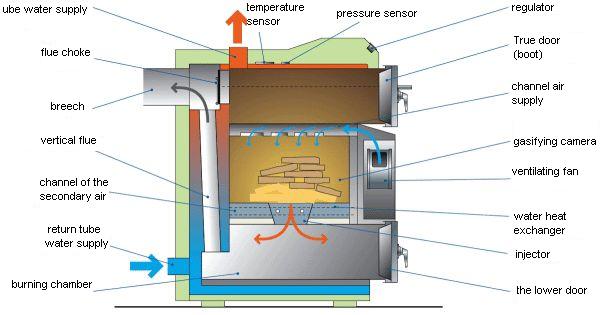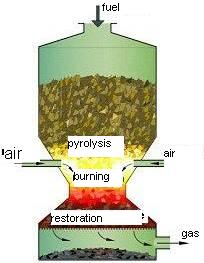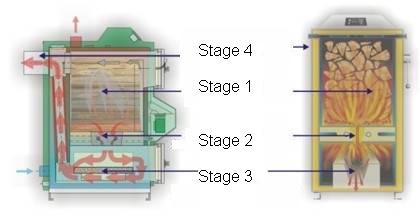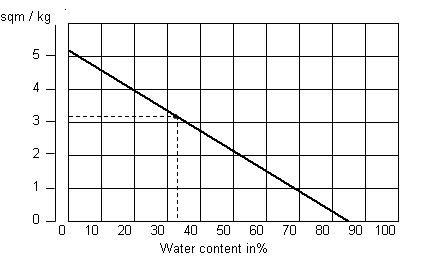Abstract
Content
- Introduction
- 1. Relevance of the topic
- 2. Purpose and research problems
- 3. The main provisions
- Conclusion
- References
Introduction
Gas-generating system at work using solid fuels, are widely used technology. Analysis and modeling of work processes that occur during operation of the gas generating systems, helps to ensure their optimal design.
Solid fuel, especially firewood, is most familiar to us. However, on current trends in the application of this type of fuel known to few. In particular, the emergence of this type of heating systems such as gas-generating boilers, can completely change our understanding of solid-fuel systems.
1. Relevance of the topic
In recent years, in Ukraine there is a trend rise in price of fossil fuels. This is especially touched by this kind of fuel like natural gas. In this connection not very good relations with Russia over the past five years, the price of natural gas to Ukraine has been steadily changed to a higher side. As a result, we have a price of $ 400 or more per 1 thousand cubic meters of natural gas. And this is not the final figure for the country. Further appreciation of the "blue" fuel for the country could become critical. And since almost the bulk of the heating companies in the country working on gas, it can be too hard to strike the tariffs for population and businesses. In this context, since recently, the President and the Cabinet took a resolution to reduce natural gas consumption and shift to other sources of heat. Basically, the choice fell on coal. Since this is the most accessible source of fuel in our country, and relatively inexpensive. Therefore, the theme of my work is closely associated with this task set by management of our country.
In his master work, I want to explore the principle of the so-called producer gas boilers (also known as pyrolysis, boilers), to determine what processes take place in them. I also plan to evaluate the fuel efficiency in this type of boiler, for what would have to find out how efficient use of one or another type of solid fuel in this boiler.
2. Purpose and research problems
The purpose of this study is a project of a new type of boiler operating on solid fuel, as well as solid combustible waste.
Main tasks of the research:
- Analysis of the processes of gasification
- Investigation of thermal processes occurring in the boiler in the boiler
- Finding and identifying the strengths and weaknesses of the boiler
- The possibility of designing such boilers of low and high power
- Changes in the design of the boiler, in order to improve its efficiency
Research object: Gas-generator boiler.
Research subject: The use of producer gas in the second stage of the boiler, to further his post-combustion, in order to improve the efficiency of the boiler.
3. The main provisions
Pyrolysis boilers (other name - the gas-generator boiler) - solid copper, based on the principle of combustion of pyrolysis (or distillation) of fuel. This boiler has a higher efficiency and, consequently, lower the amount of wood you can get more heat energy than the similar work of "traditional" boiler.
Solid fuel boiler with a combustion of pyrolysis has one major drawback - it is its price. It is an order of magnitude higher than that of conventional solid fuel boilers. However, this difference is rapidly compensated by a higher efficiency.
The design of pyrolysis boiler shown in Fig.1

Picture 1 - The design of the boiler pyrolysis
The study is based on the principle gas generator boiler combustion pyrolysis (or distillation) of fuel, the essence of which lies in the fact that under the action of heat and lack of oxygen in dry wood decomposes into volatile part - the so-called pyrolysis gas and the solid residue - the charcoal (coke).
Pyrolysis of wood is carried out at a temperature of 1100 ° C. Moreover, this process is exothermic, that is going to heat, due to which, incidentally, improves the heating and drying of the fuel in the boiler and heating is supplied to the combustion zone air.
Confusion of oxygen with the pyrolysis gas precipitated at high temperature causes the combustion process of the latter, which is then used to generate heat energy. It should be noted that the pyrolysis gas in the combustion process interacts with active carbon, resulting in flue gases leaving the boiler is practically free from harmful impurities, and are, for the most part, a mixture of carbon dioxide and water vapor. Even a pot of CO2 will emit up to 3 times smaller than regular wood, and, moreover, the coal boiler.
The pyrolysis process is shown on Fig.2

Picture 2 - The process of pyrolysis
The boiler consists of two chambers, arranged one above the other. The upper chamber is a fuel tank. It lays the wood, and here is their combustion, resulting in the stands, "wood gas". Through the process of gasification of the fuel hopper is pre-drying of wood, as well as heated air into the combustion chamber napryavlyaemogo. The lower compartment of a combustion chamber and ash at a time. Here is the process of burning wood directly to the gas and the exhaust accumulated ash. Between these two chambers is gasifying burner. Adjusting boiler output regulation occurs through the secondary air pressurization.
The stages of pyrolysis of the boiler are shown in Fig.3

Picture 3 - Stages of pyrolysis boiler
Stages of pyrolysis boiler:
- Step 1 - Drying and degassing timber. Temperature - 450 ° C
- Step 2 - Burning wood gas mixture with secondary air. Temperature - 560 ° C
- Step 3 - Reburning wood gas at a temperature of 1100 ° C (dry distillation process - pyrolysis) and heat transfer
- Step 4 - Release of exhaust chimney pin. Temperature - 160 ° C
Gasification boilers for heating is recommended that a dry timber, then provided the boiler at maximum power and long battery life. For example, a tree with a 12 - 20% water contents has calorific value of 4 kWh per 1 kg of wood, wood with 50% water contents has calorific value of 2 kWh / kg of a timber.
Graph of the the calorific value of fuel on the water content in the wood listed in Fig.4

Picture 4 - Dependence of the heating value of fuel on the water content in the wood
Conclusion
In Ukraine, the solid fuel is not only the usual, but also affordable. First and foremost, of course, this applies to coal - one of the largest coal basin is located in the territory of our country. This leads to relatively high cost of fuel in the Ukrainian market. Therefore, Ukrainian companies increasingly prefer solid fuel boilers heating systems running on gas or other liquid fuels. At the same time, pyrolysis boilers have a lot of advantages over other types of boilers fired with wood or coal. The high efficiency of this type of boiler and the ability to bookmark firewood once a day may be decisive for the company, despite a few (sometimes significantly) higher cost of boiler type retort.
This master's work is not completed yet. Final completion: December 2012. The full text of the work and materials on the topic can be obtained from the author or his head after this date.
References
- Мухина Т. Н. «Пиролиз углеводородного сырья» Т. Н. Мухина, Н. Л. Барабанов, С. Е. Бабаш — М.: Химия, 1987. — 240 с.
- «Химия и переработка угля»/ Под ред. д-ра х. н. проф. В. Г. Липовича. – М.:
- Гориславец С. П. «Пиролиз углеводородного сырья»/ С. П. Гориславец, Д. Н. Тменов, В. И. Майоров; АН УССР, Ин-т газа. – Киев: «Наук. Думка», 1977. –307 с.
- «Пиролиз углеводородного сырья»/ [Т. Н. Мухина, Н. Л. Барабанов, С. Е. Бабаши др.]. – М.: Химия, 1987. – 238 с.
- Nakamura D.N. Global ethylene capacity increases slightly in 06 [Ежегодный отчет] / D.N. Nakamura // Oil and Gas Journal. — 2007. — v.105. — № 27.
- Эффективность использования топлива. М.Б. Равич Издательство Наука. -М.: 1977. - 345 с.
- Ковернинский И. Н. Основы технологии химической переработки древесины / Рытенко В.С., Кондратьева Н.Н., Кознова О.А., Изд-во "Лесная промышленность", 1984, 183 с.
- Головков С. И. Энергитическое использование древесных отходов / Коперин И.Ф., Найденов В.И., Изд-во "Лесная промышленность", 1987, 216 с.
- Гамбург Д.Ю. Производство генераторного газа на базе твердого топлива / Семёнов, В.П. ,Химическая промышленность.-1983,152с
- Альтшулер В.С. Современное состояние и развитие технологии газификации твердого топлива // Химическая технология. - 1985.
